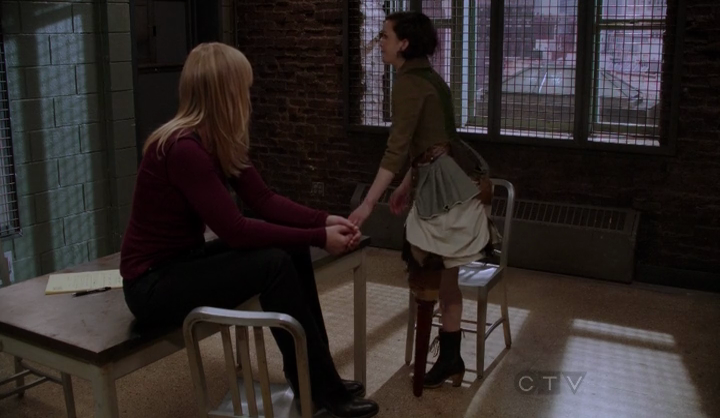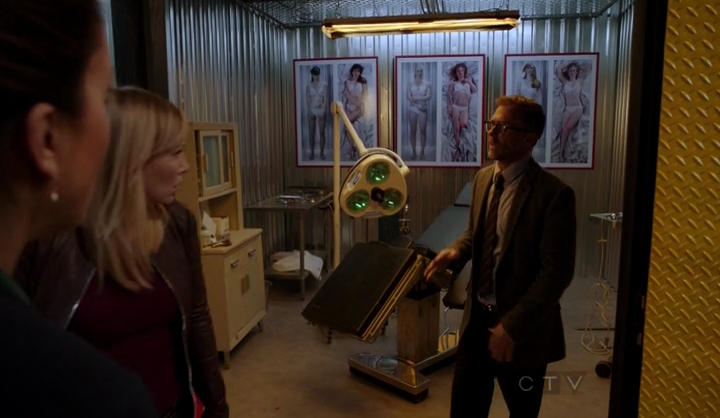Episode S13E22 “Strange Beauty”, aired May 16, 2012 IMDB
A kidnapped young woman turns up dead with an amputated leg, which leads the detectives into the body modification subculture.
Body modification is not the same thing as BDSM, though obviously there is considerable overlap of the two subcultures. The episode of SVU that focuses on body modification deploys a lot of the same tropes as episodes of procedural dramas that focus on BDSM.
Detective Rollins happens to see a woman, Nina, being abducted into a taxi cab. Nina’s mother talks about her distress at seeing her daughter’s extensive tattoos and piercings, which she said started with an octopus tattoo on her ankle.

That’s when a woman’s severed leg with an octopus tattoo turns up in a canal, which leads to another reported severed leg from years ago. The former owner of that leg is a drug-addicted street sex worker who was paid $25,000 by an unidentified john to amputate her leg.
Later, Nina’s body is found, with her leg stump stitched closed. The ME says she died because of a bad reaction to the anesthetic propofol.
Medical Examiner: “Her body, it’s a record of her journey into body modification. […] What I can tell you about this subculture is, it pushes the edge. Tattoos used to be subversive. Now kindergarten teachers have them. Which means the fringe has to go even further. I’ve seen stretched earlobes, forked tongues, steel plates implanted under the skin. Amputation is the next frontier.”
“Strange Beauty” operates on the same theory of escalation we’ve seen in other procedural dramas dealing with sexual or body-practice subcultures: one small tattoo puts a person on the road towards having a limb non-consensually amputated. Benson and Rollins even refer to the controversial “gateway drug effect” to explain Nina’s extensive body modifications, and her mutilation and death.
Other leads in the body modification community (both the high end shop with celebrity clientele and the scruffy hipster place that doubles as a bicycle repair shop) lead to a cosmetic dental clinic. Turns out the receptionist, Jess, has been stealing equipment and drugs from her employer to support her back-alley body modification business.
Another typical trope is the scene of investigators voyeuristically entering the space of the subculture. In this case, the detectives get a lead on a body modification gathering. The password is “I hardly know, sir, just at present.”, which is an on-the-nose quotation from Alice’s Adventures in Wonderland.
Inside, nothing is happening that would seem to require a password, just people with body modifications socializing, plus contortionists and aerial silk performers. Detective Rollins strikes up a conversation with a woman with elf ears, feigning interest in having the same done to herself. At least she is polite enough to ask permission to look at and touch the pointed ears.

This provides a lead to the missing dentist receptionist, Jess, who is performing body modifications in a truck in back. The camera goes in for the shock shot of Jess’ peg leg, having lost her leg to bone cancer when she was 15.
In interrogation, Jess defends her actions.
Rollins: “Let me get this straight. You see yourself as helping people be the architects of their own body.”
Jess: “Exactly.”
Tutuola: “I thought that’s what gyms are for, not blades and syringes.”
Jess: “Plastic surgeons change people’s appearance every day. Face lifts, nose jobs, breast implants.”
Tutuola: “Except they have medical licenses, and you don’t. And they buy their equipment, not steal it like you do.”
Jess says she had nothing to do with the mutilation and death of Nina, and never would. When asked about her own amputated leg, she says:
Jess: “This? I lost it to bone cancer when I was 15. Took a lot of work. But now I’m proud, because I’m extraordinary. I help people achieve their own perception of beauty. It’s a vision of their true selves. But I would never, ever subject someone to what I have been through.”

Initially, suspicion points to the dentist, but he admits he is gay and in the closet. Further investigation points to the dentist’s older brother, a psychiatrist, writing lots of prescriptions for heavy anesthetics. The brothers shared a trauma of their mother losing her leg in a car accident when they were young, which put her into a lifelong depression.
Rollins and Benson fake out the psychiatrist by claiming they’re after the dentist, and ask the psychiatrist why someone would want to amputate healthy limbs of people.
Psychiatrist: “It [the accident and the amputation] disfigured her inside and out. She lost her beauty, her leg, peace of mind. She was in a depression for the rest of her life. […] To the layperson it sounds bizarre. But I’ve seen trauma become sexualized in certain cases.”
The detectives badger the psychiatrist into admitting he knew Nina, and eventually he breaks down and confesses everything, including Nina’s accidental death.

He takes them to a storage locker which he has set up as a surgical suite, including life-size, full-length before-and-after pictures of the women he operated upon.
Psychiatrist: “Nina was a tragedy, but none of the other five had any problems. They’re more complete now because of me. I transformed them. Why can people accept sex reassignment surgery but not this?”
Rollins: “This all started with Jess, didn’t it?”
Psychiatrist: “Yes. But I never laid a hand on her. It’s just that, when she lost her leg, she was so amazing. The way she embraced her new body. It was the most courageous thing I’ve ever seen. I thought, all women should be like her. Not like–”
Rollins: “Your mother? You couldn’t save her, so you save all these other girls, by transforming them.”
[…]
Psychiatrist: “Every few years there’d be a new girl. And I’d pay her. And she’d be grateful for what I did for her. But there’s only so many like that.”
Benson: “And that’s why you went after Nina.”
Psychiatrist: “If Nina’s heart hadn’t stopped, She would have been grateful too. Society’s not ready for me. I can look at women and know how beautiful and powerful they can be. Like you two. You think you’re special? You’re boring. But you could be so much more.”
After the standard villain rant, the detectives cuff him.
“Strange Beauty” awkwardly conflates three related but distinct peoples: acrotomophiles (people who fetishize amputees), people who voluntarily alter their own bodies, including rare extreme cases of wanting to amputate their own limbs (known as apotemnophiles, or more clinically as people with body integrity dysphoria), and people who have involuntarily had their limbs amputated.
Of the amputee women in this story, two lost their legs due to medical necessity, the third was coerced by economic desperation, and the fourth was kidnapped and drugged. The other four women amputees were troubled people who were convinced into this by a disturbed man with a lot of money. None of these cases were consensual.
That brings up an implausibility: did none of the other four women have regrets or second thoughts about what they allowed to have done to them, and report the man? For that matter, how did they explain their missing limbs to other people if they had no history of physical illness?
It’s somewhat more plausible that the psychiatrist would have connected with people with body integrity dysmorphia and performed the amputations on them. But that would complicate the story, making the psychiatrist less of a monster and the amputees imperfect victims. It sidesteps the thorny ethical issue of people who desperately want to have their bodies radically modified. Body integrity dysphoria is conspicuous in its absence.
The anxiety about voluntary body modification is displaced onto a familiar figure, the “mad scientist”/”obsessed fetishist”, complete with an origin story of childhood trauma. The demands of neat narrative resolution require an unambiguous villain, a monster who can be expelled from the ideological category of “normal.”



